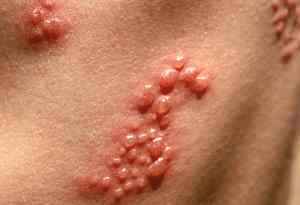

MedFriendly®


Shingles
Shingles is a painful rash that is caused by the second
outbreak of the virus that initially causes chickenpox.
This virus is known as the varicella-zoster virus. After
this virus causes chickenpox, it stays in the body but
goes into in an inactive state. Shingles is caused
when this virus becomes active again. Since most
adults have had chickenpox as a child, they are at risk
of developing shingles in the future.
Blisters that are characteristics of shingles.
FEATURED BOOK: Shingles: New Hope for an Old Disease
WHAT ARE THE SIGNS AND SYMPTOMS OF SHINGLES?
side of the body, usually part of the chest or back (see below). The rash and blisters
extend from a strip of skin that is supplied from one of the spinal nerves, which exits from
the spinal cord. The reason for this is because the virus that causes shingles lives in the
nerves throughout one’s life. The rash may extend along the complete strip of skin or it
may have a broken appearance. The rash and blisters can also occur in other areas of
the body, such as the neck and face.
If the rash and blisters go near the eyes, this will need to be evaluated by an
ophthalmologist because permanent visual loss can result. An ophthalmologist is a
medical doctor that specializes in ophthalmology, which is the science that deals with the
structure, functions, and diseases of the eye, as well as the diagnosis and treatment of
such diseases.
"Where Medical Information is Easy to Understand"™
Shingles can result in nerve damage, causing burning, aching, or
sharp pain in the areas where the rash and blisters were located
(after they have healed). The skin may become very sensitive to
changes in temperature and touch. This painful complication of
shingles is referred to as post-herpetic neuralgia.
IS SHINGLES CONTAGIOUS?
The virus that causes shingles can only be passed on to someone
who has not already had chickenpox.
HOW IS SHINGLES TREATED?
At the first sign of burning, itchiness, or tingling, doctors recommend seeking medical treatment. The main
treatment for shingles is medications designed to fight the virus that causes it. One of the most popular
drugs for this purpose is acyclovir. This medication is most effective when it is used within three days of
the appearance of a rash. Other drugs used to treat shingles include anti-inflammatory medications, since
they are designed to reduce inflammation. Pain medications are also used. Itchiness and burning can also
be relieved by applying cold compresses and soothing lotions.
For the treatment of post-herpetic neuralgia (see above), doctors often recommend anti-depressant
medication, certain types of anti-seizure medication, and/or capsaicin cream (a natural type of pain
relieving cream). Capsaicin is available without a prescription.
CAN SHINGLES BE PREVENTED?
If one did not develop chicken pox as a child, shingles can be prevented by receiving an injection of the
varicella vaccine. The vaccine is an injection of a weakened form of the varicella zoster virus which
causes the body to produce certain proteins (known as antibodies) that protect the body from future
infections caused by this virus.
WHAT ELSE IS SHINGLES KNOWN AS?
Shingles is also known as herpes zoster.
WHAT IS THE ORIGIN OF THE TERM, SHINGLES?
Shingles comes from the Latin word “cingulum” meaning “girdle.” This is because shingles often produces
a girdle of blisters along the waist.















